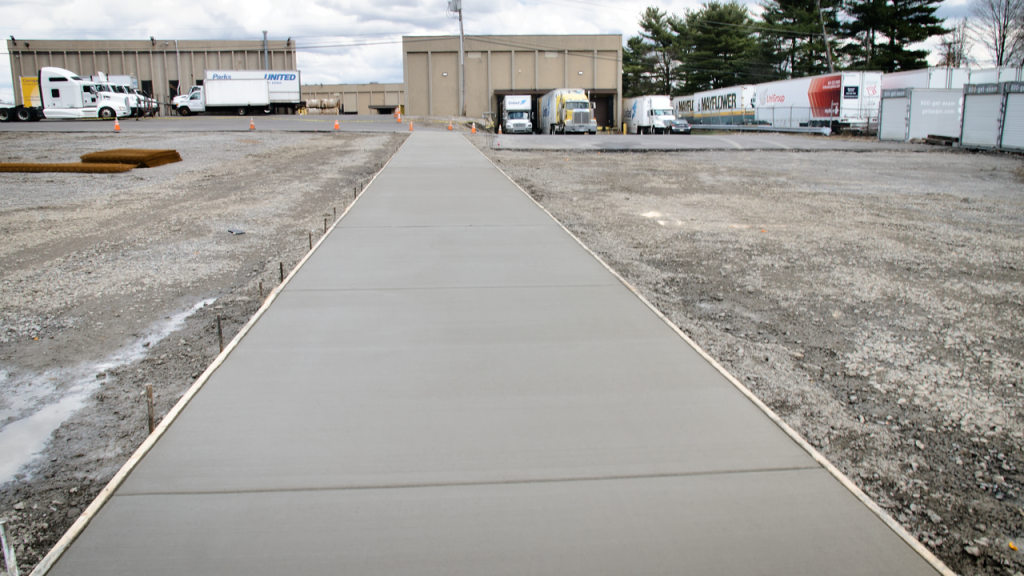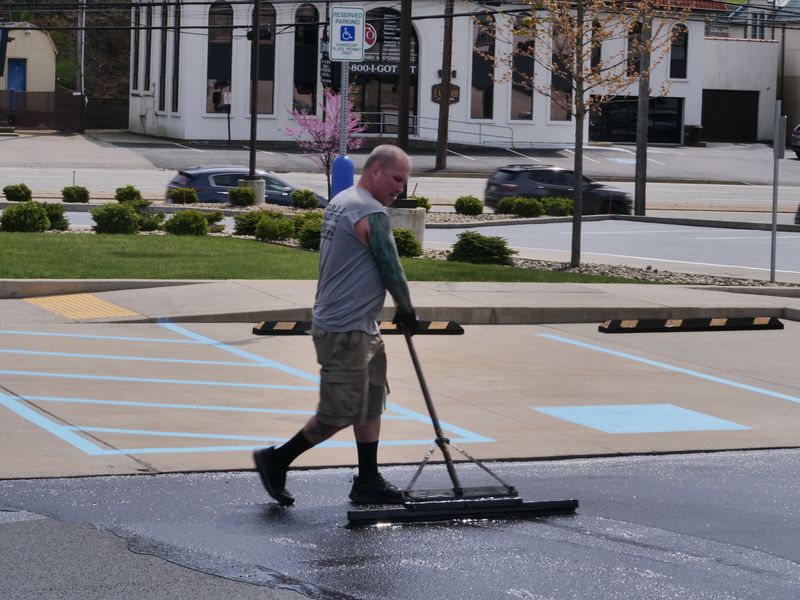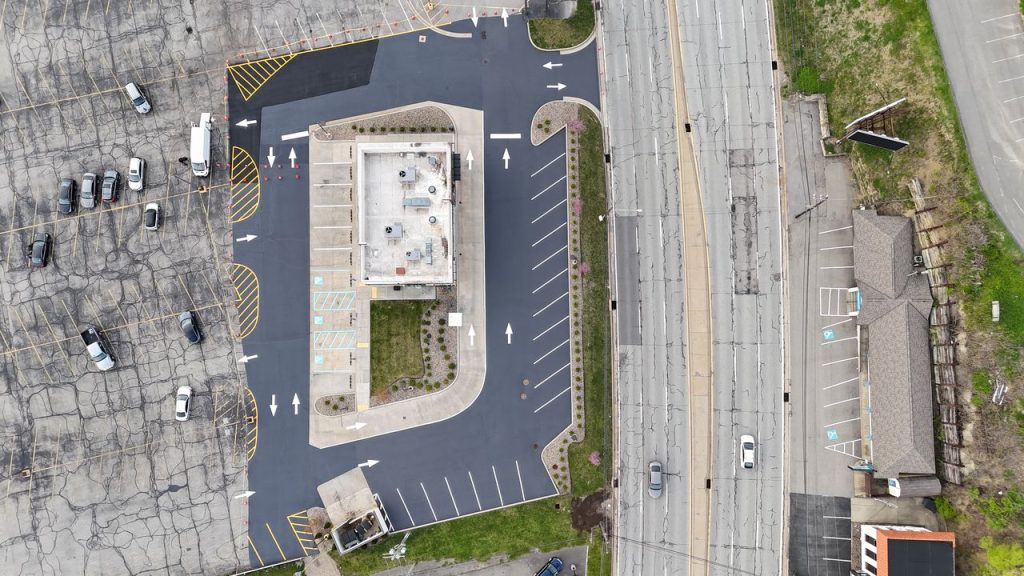Not every parking lot problem means you need a full replacement. If you own or manage a commercial property, you’ve probably asked yourself whether a repair will do the job or if it’s time to start over. Here’s some good news. There’s a middle ground that saves you money and extends the life of your pavement. It’s called an asphalt overlay, and in many cases, it’s exactly what your commercial parking lot needs.
At The Pavement Group, we work with businesses across the U.S., from Pittsburgh to Phoenix, helping them understand the smart way to protect their investments. Asphalt overlays are one of the most cost-effective tools in commercial pavement maintenance—but only when used at the right time. In this post, we’ll walk you through when to choose an asphalt overlay, how the process works, and what signs to watch for before it’s too late.
What Is an Asphalt Overlay?
Let’s break it down. An asphalt overlay is when a new layer of asphalt is laid directly over an existing surface. You don’t have to dig up the whole parking lot or start from scratch. Instead, your contractor inspects the condition of the lot, makes minor repairs if needed, and then paves a fresh layer right on top.
This new layer, usually about 1.5 to 2 inches thick, covers surface damage, refreshes the look of the lot, and restores the smooth driving experience your customers and tenants expect. It’s not a cure-all, but when done right, it can add up to 10–15 years of life to your commercial parking lot.
It’s important to understand that an overlay is not the same as a full-depth replacement. It does not remove the base layers of your existing pavement. So the key to success is making sure the foundation underneath is still strong. That’s why knowing when to choose an asphalt overlay makes all the difference.
Signs Your Parking Lot Is a Good Candidate for an Overlay
Every lot tells a story. You just need to know how to read it. Here are some common signs that it may be time to consider an overlay:
1. Surface Cracking
If your lot has alligator cracking or long surface cracks, but the cracks don’t go deep into the base, an overlay can be effective. Small to moderate surface damage is often a cosmetic issue and not a structural one.
2. Minor Drainage Problems
Slight water pooling in low spots can usually be fixed with an overlay. Severe drainage issues, however, may require more intensive repair before overlaying.
3. Aging Asphalt
If your asphalt is 10 to 15 years old and showing wear, an overlay is often cheaper and faster than waiting until complete failure. Think of it like preventative maintenance for your entire lot.
4. No Major Foundation Failures
An overlay is only as good as the base beneath it. If your lot has widespread rutting, deep potholes, or sub-base erosion, a full-depth reclamation or replacement might be the better path.
The Overlay Process: What to Expect
At The Pavement Group, we keep the process simple and professional. Here’s what typically happens during an asphalt overlay project:
- Inspection & Evaluation
We evaluate the condition of your lot and identify any areas that need patching or leveling. - Milling (If Needed)
We may remove a thin layer of existing asphalt (called milling) to help the new layer bond better and maintain proper grading. - Cleaning & Preparation
Debris, vegetation, and loose materials are cleared. A tack coat (adhesive) is applied to help the new asphalt layer stick. - Paving
Fresh hot-mix asphalt is laid, smoothed, and compacted with heavy rollers. This gives your lot a seamless, like-new surface. - Striping & Finishing Touches
We repaint your parking lines and ADA markings. If requested, we can also upgrade your layout for better flow and compliance.
Benefits of Asphalt Overlay for Commercial Lots
Choosing an overlay comes with several advantages—especially for business owners looking to balance quality with budget.
- Cost Savings: An overlay is significantly more affordable than a full replacement.
- Minimal Downtime: Most overlays can be completed in 1–2 days.
- Enhanced Appearance: Your parking lot will look brand new to visitors.
- Improved Safety: Smooth pavement reduces trip hazards and tire damage.
- Extended Lifespan: With proper maintenance, you can get another decade or more out of your lot.
Local Testimonial from a Commercial Client
“We manage a retail center just outside of Pittsburgh and were getting complaints about the parking lot’s condition. The Pavement Group evaluated it and recommended an asphalt overlay instead of tearing everything up. They completed the project in under two days and it made a huge difference. The lot looks brand new, and we saved thousands compared to a full replacement. Their team was honest, fast, and professional from start to finish.”
— Stephanie L., Property Manager, Allegheny County PA
Your Parking Lot Could Be One Smart Move Away.
Why wait for full failure when you can act now? The Pavement Group specializes in asphalt overlays for commercial parking lots just like yours. We assess your pavement, offer straightforward advice, and deliver expert solutions that save time and money.
Call us today or schedule your FREE lot evaluation online. Let’s make your pavement look better, last longer, and perform like it should.
Frequently Asked Questions
1. What is an asphalt overlay for commercial parking lots?
An asphalt overlay is a new layer of asphalt applied over existing pavement. It improves surface condition without removing the entire base. It’s used when the structure is still sound but the surface is worn.
2. When should I choose an overlay instead of full replacement?
If your lot has surface cracks, minor potholes, or aging asphalt but no base failure, an overlay is ideal. It’s faster and more affordable than a full replacement. A professional assessment can confirm if it’s the right choice.
3. How long does an asphalt overlay last?
A properly installed overlay can last 10 to 15 years. Its lifespan depends on the condition of the underlying pavement and ongoing maintenance. Sealcoating and crack filling can help extend its life.
4. How thick is an asphalt overlay layer?
Typical overlays are 1.5 to 2 inches thick. The thickness may vary depending on traffic load and existing surface condition. Thicker overlays may be used in high-traffic areas.
5. Is milling required before applying an overlay?
Milling may be needed to maintain proper elevations and drainage. It helps the new asphalt bond better and reduces height issues near curbs or structures. Your contractor will recommend it based on your lot’s condition.
6. Can an overlay fix drainage problems?
Minor drainage issues can be addressed with surface leveling and overlay. Major grading problems may require additional work like base repair or regrading. Proper slope and flow are critical for pavement life.
7. Will an overlay fix potholes in my parking lot?
Yes, but only if the potholes are repaired first. The damaged areas are patched before the new layer is added. This ensures a smooth and long-lasting finish.
8. How much does an asphalt overlay cost?
Costs vary based on square footage, prep work, and materials. On average, overlays cost 30–40% less than full replacement. Getting a quote from a trusted contractor gives the most accurate estimate.
9. How long before I can drive on the new overlay?
Most overlays cure in 24 to 48 hours, depending on weather. After that, vehicles can return. Striping is usually done once the surface cools and sets.
10. Is an asphalt overlay environmentally friendly?
Yes. Overlays use less raw material and reduce waste compared to full replacements. Milling and recycling old asphalt also contribute to sustainable pavement practices.


